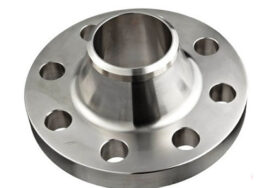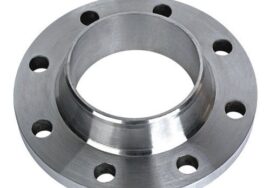
ASTM A182 Gr F321
Any austenitic stainless steel component, like the Inox 316L Slip On Flange, that contains nitrogen boosts both the yield strength and austenite stability. maritime grade steel, also known as grade 316L stainless steel flanges, is utilised in industries like maritime engineering where welding is necessary. While guaranteeing that the mechanical characteristics of SS 316L Blind Flange are nearly identical to those of the traditional alloy, grade 316, the addition of nitrogen also strengthens the alloy’s resistance to pitting. Higher creep, stress to rupture, and tensile strength at high temperatures are provided by the molybdenum bearing ASME SA182 F316L Pipe Flange in contrast to austenitic stainless steel grades based on chromium and nickel.
For applications up to around 900 °C, ASTM A182 F321 is a good option because it combines resistance to subsequent aqueous corrosion with excellent strength, scaling resistance, and phase stability. Because A182-F321 has more carbon, it is stronger at high temperatures. It can withstand oxidation well up to 900 °C when used intermittently and up to 925 °C when used continuously. It works well in the 425–900 °C range, particularly in the presence of aqueous corrosive conditions. It is especially well-suited for high-temperature structural applications due of its increased hot strength.
SA182 F321 does not require post-weld heat treatment and has good weldability, making it easy to weld using all common fusion techniques with or without filler metals. In addition, ASTM A182 Grade F321 is non-magnetic when annealed and has good low temperature toughness. Applications include chemical processing, food processing, aerospace, petroleum refining, pharmaceutical production, etc. can benefit from SA 182 F321.
A pipeline system can be formed by joining pipes, valves, pumps, and other tools using 321H stainless steel flanges. It also provides simple access for maintenance, cleaning, or inspection. Usually, screws or welding are used. In order to create ASTM A182 F321H Stainless Steel Flanges, two flanges are bolted together with a gasket in between to create a seal. Titanium can be added to this austenitic material to stabilise it. Typically, it can be used in settings where temperatures reach 1,650 °F. A flange without a hub or a bored centre is known as an SS 321H Blind Flange. Its bolting pattern is identical, and it has a face type that matches and a thickness comparable to a flange. It can be applied to a pressure vessel’s nozzle opening to seal it. It resists future aqueous corrosion and possesses excellent strength, phase stability, and resistance to scale. Welding Stainless Steel 321H Socket Flanges are typically utilised on high pressure pipes that are smaller in size. The pipe is inserted into the socket end, and fillet weld is applied around the top to secure it. This contributes to the fluid or gas inside the pipe flowing more smoothly and having a better bore.
Weld neck flanges SA 182 F321H have a circular fitting with a peek rim around the outside. usually machined from a forging that has been attached to a pipe via butt welding. Gr F321H, ASTM A182 Put on and remove your shoes. Joint flanges are made up of the backing flange and the stub end. The gasket is positioned at the juncture where the stub end slips over the pipe. Threaded flanges, ASTM A182 321H, are a unique kind of flange that can be fastened to a pipe without the need for welding. It is threaded in the bore to match the pipe’s exterior thread. It functions similarly to slip-on pipe flanges used with pipes having exterior threads.It can be applied in situations requiring both high pressure and tiny diameter. To measure the flow rate of oil, gas, and other liquids transported by pipeline, UNS S32109 Orifice Flanges are used in conjunction with orifice metres. Long, tapering hubs are used in ASTM A182 321H SS Long Weld Neck Flanges to increase pipe thickness from the weld to the flange face. By transferring the internal stress caused by the high-pressure liquid flow to the pipe, this design lessens the tension on the flange itself.
A182 F321 Material Specification
Manufacturer of ASTM A182 F321 Threaded, Forged and Plate Flanges for Raised and Flat Face connections
| Selling Grade | ASTM A182 F321/ ASME SA182 F321 ASTM A182 F321H/ ASME SA182 F321H |
|---|---|
| Most common types of ASTM A182 Grade F321 Flanges |
|
| Ranging in size from | 1/2 Inch (15 NB) to 48 Inch (1200NB) DN10~DN5000 |
| A182 F321 Material Test Reports ask from the manufacturer |
|
| ASTM A182 Gr F321 Flange Standard | BS4504, BS 10, ASME B16.5, B16.47 Series A & B, B16.48, EN-1092, DIN, ANSI, ASME, EN, GOST. |
| Most common Flanges manufacturing methods | Forged / Plate/Threaded / Screwed |
| ASTM A182 Gr F321 supporting material | Gasket, Ring Joint, Flanges Bolts |
| A182 F321 Material pressure class | Class 150 LBS, 300, 600, 900, 1500, and 2500 # |
| SA182 F321 Technique used |
|
| ANSI Pressure Rating | Class 150, 300, 600, 900, 1500, 2500 |
| DIN Pressure class | 6Bar 10, 16, 25, 40 and PN6 PN10 PN16 PN25 PN40, PN64 |
| JIS Rating | 5K, 10, 16 20, 30, 40, 63 |
| UNI Rating | 6Bar, 10, 16, 25, 40 |
| EN Rating | 6Bar, 10, 16, 25, 40 |
| ASTM A182-F321 Facing Type | Groove, Raised Face (RF), Lap-Joint Face (LJF), Flat Face (FF), Large Male-Female (LMF), Small Tongue, Ring Type Joint (RTJ), Small Male-Female (SMF), Large Tongue & Groove, |
| Origin of ASTM A182 F321 Material | USA / India / West Europe / Japan /Korea |
| ASTM A182 F321 Material Test Certificates (MTC) as per EN 10204 3.1, EN 10204 3.2, NACE MR0103, NACE MR0175 | |
A182 F321 Equivalent
| ASTM | STANDARD | WNR | UNS | JIS | EN |
|---|---|---|---|---|---|
A182 | SS 321 | 1.4541 | S32100 | SUS 321 | X6CrNiTi18-10 |
SA 182 F321 Stainless Steel Flanges Mechanical & Physical Properties
| Density | 8.0 g/cm3 |
|---|---|
| Melting Point | 1454 °C (2650 °F) |
| Tensile Strength | Psi – 75000 , MPa – 515 |
| Yield Strength (0.2%Offset) | Psi – 30000 , MPa – 205 |
| Elongation | 35 % |
A182 Gr F321 Chemical Composition
| SS 321 | |
|---|---|
| Ni | 9 – 12 |
| Cr | 17 – 19 |
| C | 0.08 max |
| N | 0.10 max |
| Fe | Balance |
| Mn | 2 max |
| Si | 0.75 max |
| S | 0.03 max |
| P | 0.045 max |
| Ti | 5xC min 0.60% max |





